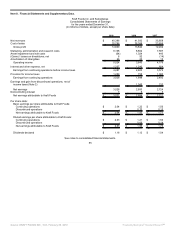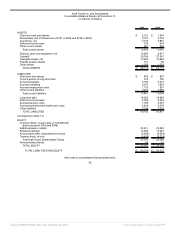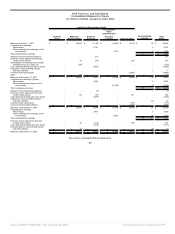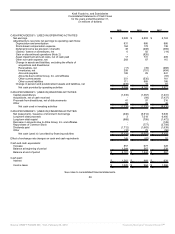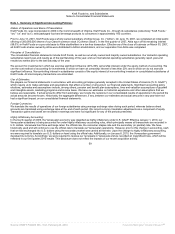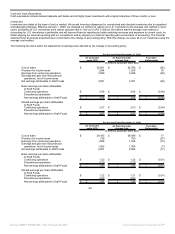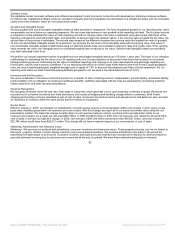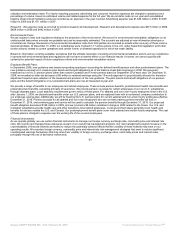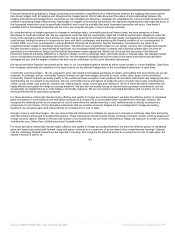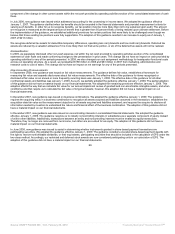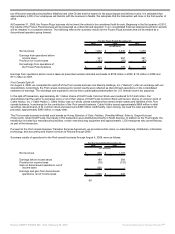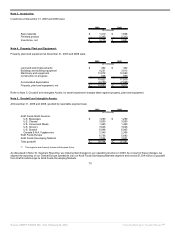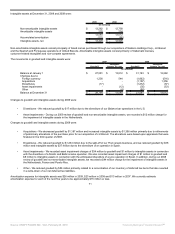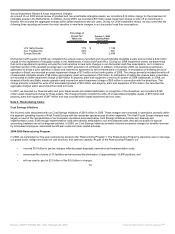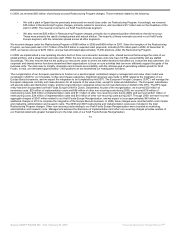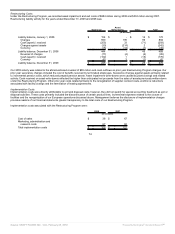Kraft 2009 Annual Report Download - page 68
Download and view the complete annual report
Please find page 68 of the 2009 Kraft annual report below. You can navigate through the pages in the report by either clicking on the pages listed below, or by using the keyword search tool below to find specific information within the annual report.
interest and other expense, net for our hedges of intercompany loans, when the payments are made. For those derivative instruments that we
consider economic hedges but do not designate for hedge accounting treatment, we recognize gains and losses directly as a component of cost of
sales or interest and other expense, net, depending on the nature of the underlying transaction.
Interest rate cash flow and fair value hedges - We manage interest rate volatility by modifying the repricing or maturity characteristics of certain
liabilities so that the net interest margin is not, on a material basis, adversely affected by movements in interest rates. As a result of interest rate
fluctuations, hedged fixed-rate liabilities appreciate or depreciate in market value. The effect of this unrealized appreciation or depreciation is
expected to be substantially offset by our gains or losses on the derivative instruments that are linked to these hedged liabilities.
We use derivative instruments, including interest rate swaps that have indices related to the pricing of specific liabilities as part of our interest rate
risk management strategy. As a matter of policy, we do not use highly leveraged derivative instruments for interest rate risk management. We use
interest rate swaps to economically convert a portion of our nonprepayable fixed-rate debt into variable-rate debt. Under the interest rate swap
contracts, we agree with other parties to exchange, at specified intervals, the difference between fixed-rate and floating-rate interest amounts,
which is calculated based on an agreed-upon notional amount. We also use interest rate swaps to hedge the variability of interest payment cash
flows on a portion of our future debt obligations. Substantially all of these derivative instruments are highly effective and qualify for hedge
accounting treatment.
For those derivative instruments that are highly effective and qualify for hedge accounting treatment, we either record the impacts in current period
earnings or defer the effective portion of unrealized gains and losses as a component of accumulated other comprehensive earnings / (losses),
depending on whether the hedging relationship satisfies the criteria for a fair value or cash flow hedge. For fair value hedges, we record both
(i) the gains or losses on interest rate swaps and (ii) the corresponding changes in fair value of the hedged long-term debt directly as a component
of interest and other expense, net. For cash flow hedges, we recognize the deferred portion as a component of interest and other expense, net
when we incur the interest expense. The ineffective portion is directly recorded as a component of interest and other expense, net. For the
derivative instruments that we consider economic hedges but do not designate for hedge accounting treatment, we recognize gains and losses
directly as a component of interest and other expense, net.
Hedges of net investments in foreign operations - We have numerous investments in foreign subsidiaries. The net assets of these subsidiaries are
exposed to volatility in foreign currency exchange rates. We use foreign-currency-denominated debt to hedge our net investment in foreign
operations against adverse movements in exchange rates. We designated our euro denominated borrowings as a net investment hedge of a
portion of our overall European operations. The gains and losses on our net investment in these designated European operations are
economically offset by losses and gains on our euro denominated borrowings. The change in the debt’s fair value is recorded in the currency
translation adjustment component of accumulated other comprehensive earnings / (losses).
Guarantees:
Authoritative guidance related to guarantor’s accounting and disclosure requirements for guarantees requires us to disclose certain guarantees
and to recognize a liability for the fair value of the obligation of qualifying guarantee activities. See Note 13, Commitments and Contingencies for a
further discussion of guarantees.
Income Taxes:
Prior to our spin-off from Altria, we were included in Altria’s consolidated federal income tax return. We generally computed income taxes on a
separate company basis; however, some of our foreign tax credits, capital losses and other credits could not be used on a separate company
basis. To the extent that Altria used our foreign tax credits and other tax benefits in its consolidated federal income tax return, we recognized the
benefit in the calculation of our provision for income taxes. This benefit was approximately $270 million in 2007. We made payments to, or were
reimbursed by, Altria for the tax effects resulting from being included in Altria’s tax return. As of March 31, 2007, we were no longer a member of
the Altria consolidated tax return group. We file our own federal consolidated income tax returns. As a result of the spin-off, Altria transferred our
federal tax contingencies to our balance sheet and related interest income of $77 million in 2007. Additionally, during 2007, Altria paid us $305
million for the federal tax contingencies held by them, less the impact of federal reserves reversed due to the adoption of new guidance, discussed
below, which addressed accounting for the uncertainty in income taxes. This amount was reflected as a
65
Source: KRAFT FOODS INC, 10-K, February 25, 2010 Powered by Morningstar® Document Research℠


